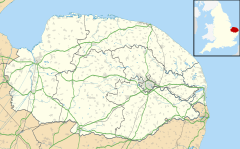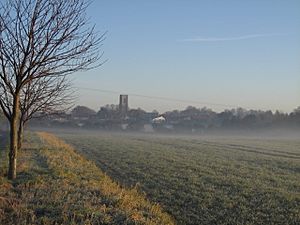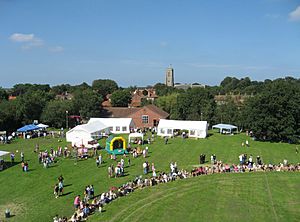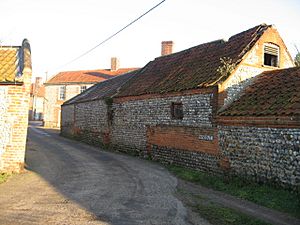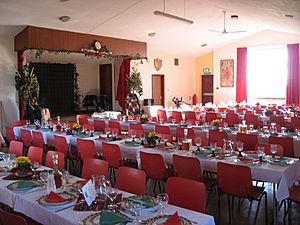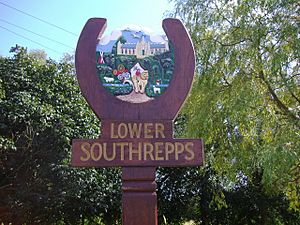Southrepps facts for kids
Quick facts for kids Southrepps |
|
|---|---|
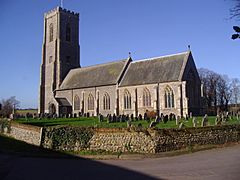 St James' Parish Church, Southrepps |
|
| Area | 8.45 km2 (3.26 sq mi) |
| Population | 815 (2011 census) |
| • Density | 96/km2 (250/sq mi) |
| OS grid reference | TG256367 |
| • London | 136 miles (219 km) |
| Civil parish |
|
| District | |
| Shire county | |
| Region | |
| Country | England |
| Sovereign state | United Kingdom |
| Post town | NORWICH |
| Postcode district | NR11 |
| Dialling code | 01263 |
| Police | Norfolk |
| Fire | Norfolk |
| Ambulance | East of England |
| EU Parliament | East of England |
| UK Parliament |
|
Southrepps is a friendly village located in Norfolk, England. It's about 5.2 miles (8.4 km) southeast of Cromer and 21.9 miles (35.2 km) north of Norwich. The village is also about 136 miles (219 km) north of London. Southrepps is close to the sea and surrounded by rich farmland. The nearest train station is Gunton, which is on the Bittern Line. This line connects Sheringham, Cromer, and Norwich. If you need to fly, the closest airport is Norwich International Airport.
Contents
Exploring Southrepps: Two Halves of a Village
Southrepps is actually split into two parts. These two halves are separated by about a mile of farmland. They are known as Upper Southrepps and Lower Southrepps. On maps, you might see them called Upper Street and Lower Street.
Nature and Landscape: The Geography of Southrepps
Southrepps is built on a gentle slope made of sand and gravel left behind by glaciers. It also has rich soil from an older period when a large river flowed through a forest. This type of ground means the soil drains well and is very fertile.
Beneath these younger rocks, there are layers of chalk. You can see this chalk on the nearby beach at low tide, between Trimingham and Sidestrand. The beach is full of flint stones. These flints were formed inside the chalk and then smoothed by ocean waves. People in the village used these strong, common flint stones to build houses and for decoration. Local clay and orange roof tiles from other countries were used for roofs.
Weather and Climate in Southrepps
Southrepps is in the east of England, which means it's protected from most of the extreme weather that comes from the Atlantic Ocean. This makes it one of the driest places in the UK, getting less than 500 millimeters of rain each year. The average temperature is about 10 °C, which is quite mild. In summer, when winds blow from the south or west, temperatures can easily go above 20 °C and sometimes even over 30 °C. Because the sea is close, very cold frosts are rare. However, in December 2011, the temperature did drop to -13.8 °C.
The village gets over 1,550 hours of sunshine every year. This is a lot, though not as much as the very south coast of England. Sometimes in spring and early summer, fog can roll in from the North Sea. This happens when warm, moist air from Europe meets the colder sea. So, you might find the village sunny while the roads leading to the coast are covered in thick mist!
Farming Through the Ages
The climate and geology of Southrepps have made the area excellent for farming. For a long time, even since the Middle Ages, people mainly grew crops and raised sheep. Big events like the Black Death and Great Plague did slow down farming for a while.
During the Second World War, farming became much more intense. It has stayed that way since, with large fields used for growing cereals and root crops. However, some local farmers and landowners have worked hard to replant trees and hedgerows. This helps bring back the traditional look of the countryside.
Life in Southrepps: Village Amenities
Southrepps has some useful places for its residents. There are two shops where you can buy things and one public house (a pub) called the Vernon Arms. The village hall is a busy place! It hosts many regular groups and special events. These include wedding parties, christenings, funerals, and annual village celebrations. It's also where the Southrepps Society, a group of local historians, meets.
The local parish church, called St James, offers different kinds of worship services. Southrepps also has a primary school called Antingham & Southrepps CP, where younger children go to learn.
Community Groups and Activities
Southrepps has many active groups that bring people together:
- The Royal British Legion has a local branch with about 30 members. They meet every three months at the Vernon Arms pub.
- Local bell-ringers meet every Wednesday evening at 7:30 pm at the parish church to practice.
- The Southrepps Society started in 1979. Its goal is to celebrate and protect the best parts of Southrepps. They have a "Memories Project" that started in 2006. This project shares the Society's old records and involves the village in community events and exhibitions. Their current project is looking into the history of farming in the area, and the local school is helping with it.
- There's a long-running Southrepps and District Women's Group. They meet on the third Tuesday of each month at Thorpe Market Village Hall, which is nearby. There's also a Women's Reading Group for those who love books.
- The Village Fayre Committee organizes popular summer fairs. These fairs, like the ones in 2007 and 2009, attracted many visitors and raised lots of money for local charities. They also helped start other events to bring villagers together, such as the "Carols-Round-The-Four-Village-Trees" event in December, which raises money for a local children's hospice.
- Every summer, the Southrepps Classical Music Festival brings famous singers and musicians to the village. They perform many different types of classical music. About 30 village families host these musicians during the festival.
Southrepps Common: A Special Nature Spot
Southrepps Common is a very important natural area. It's a biological Site of Special Scientific Interest and a Local Nature Reserve. It covers about 12.4 hectares (about 30 acres) and is located in Lower Southrepps.
This special place has woodland, reedbeds, and many kinds of grasses and wild flowers. There's an 800-meter (half-mile) boardwalk that lets everyone, including those using wheelchairs, explore the most interesting parts of the reserve. Because it has so many different natural areas, it's home to an amazing variety of plants and animals. It even has "Special Area of Conservation" status, which means it's protected at a European level.
Plants and Wildlife at Southrepps Common
You can find over 160 different plant species at Southrepps Common, including some small orchids. Some of the plants you might see are:
- Parnassus grass (Parnassia)
- Bog pimpernel (Anagallis tenella)
- Flea sedge (Carex pulicaris)
- Common cottongrass (Eriophorum angustifolium)
- Marsh helleborine (Epipactis palustris)
- Bogbean (Menyanthes)
- Marsh marigold (Caltha palustris)
The reserve is also a great place for birds. Many birds nest here, like reed warblers, reed bunting, and sedge warbler. In the woodland areas, you might spot birds such as the greater spotted woodpecker, nuthatch, treecreeper, barn owl, and tawny owl.
A shallow, clear stream called Fox's Beck flows through the common. This stream is home to several types of snails, caddis fly larvae, and dragonfly larvae. You might even see water voles living along the banks!
For a long time, people living near Fox's Beck and the common had special "common rights." This meant they could use natural resources from the land. For example, they could cut peat for fuel (called turbary), collect firewood and bedding for their animals (called estovers), and fish (called piscary). They could also let their livestock graze there. Other resources gathered included reeds for thatch, alder and hazel wood for tool handles, twigs for broom heads, and willow for screens.
Famous People from Southrepps
- John Dolphin (1837–1899) was a cricketer and clergyman who was born in Southrepps.
See also
 In Spanish: Southrepps para niños
In Spanish: Southrepps para niños


